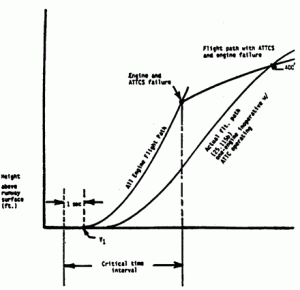Content last revised: 2003/06/05
Subchapters
- A (525.1-525.2),
- B (525.21-525.255),
- C (525.301-525.581),
- D (525.601-525.899),
- E (525.901-525.1207),
- F (525.1301-525.1461),
- G (525.1501-525.1587)
- H (525.1701-525.1733)
Appendices
A, B, C, D, E, F, G, H, I, J, K, L, M, N, O
(2001/06/01; no previous version)
Appendix I
Installation of an Automatic Take-off Thrust Control System (ATTCS)
I525.1 General
- (a) This appendix specifies additional requirements for installation of engine power control system that automatically resets thrust or power on operating engine(s) in the event of any one engine failure during take-off.
- (b) With the ATTCS and associated systems functioning normally as designed, all applicable requirements of Chapter 525, except as provided in this appendix, must be met without requiring any action by the crew to increase thrust or power.
I525.2 Definitions
- (a) Automatic Take-off Thrust Control System (ATTCS). An ATTCS is defined as the entire automatic system used on take-off, including all devices, both mechanical and electrical, that sense engine failure, transmit signals, actuate fuel controls or power levers or increase engine power by other means on operating engines to achieve scheduled thrust or power increases, and furnish cockpit information on system operation.
- (b) Critical Time Interval. When conducting an ATTCS take-off, the critical time interval is between V1 minus 1 second and a point on the minimum performance, all-engine flight path where, assuming a simultaneous occurrence of an engine and ATTCS failure, the resulting minimum flight path there after intersects the Chapter 525 required actual flight path at no less than 400 feet above the take-off surface. This time interval is shown in the following illustration:
I525.3 Performance and System Reliability Requirements
The applicant must comply with the performance and ATTCS reliability requirements as follows:
- (a) An ATTCS failure or a combination of failures in the ATTCS during the critical time interval:
- (1) Shall not prevent the insertion the maximum approved take-off thrust or power, or must be shown to be an improbable event.
- (2) Shall not result in a significant loss or reduction in thrust or power, or must be shown to be an extremely improbable event.
- (b) The concurrent existence of an ATTCS failure and an engine failure during the critical time interval must be shown to be extremely improbable.
- (c) All applicable performance requirements of Chapter 525 must be met with an engine failure occurring at the most critical point during take-off with the ATTCS system functioning.
I525.4 Thrust Setting
The initial take-off thrust or power setting on each engine at the beginning of the take-off roll may not be less than any of the following:
- (a) Ninety (90) percent of the thrust or power set by the ATTCS (the maximum take-off thrust or power approved for the aeroplane under existing ambient conditions);
- (b) That required to permit normal operation of all safety-related systems and equipment dependent upon engine thrust or power lever position; or
- (c) That shown to be free of hazardous engine response characteristics when thrust or power is advanced from the initial take-off thrust or power to the maximum approved take-off thrust or power.
I525.5 Powerplant Controls
- (a) In addition to the requirements of 525.1141, no single failure or malfunction, or probable combination thereof, of the ATTCS, including associated systems, may cause the failure of any powerplant function necessary for safety.
- (b) The ATTCS must be designed to:
- (1) Apply thrust or power on the operating engine(s), following any one engine failure during take-off, to achieve the maximum approved take-off thrust or power without exceeding engine operating limits;
- (2) Permit manual decrease or increase in thrust or power up to the maximum take-off thrust or power approved for the aeroplane under existing conditions through the use of the power lever. For aeroplanes equipped with limiters that automatically prevent engine operating limits from being exceeded under existing ambient conditions, other means may be used to increase the thrust or power in the event of an ATTCS failure provided the means is located on or forward of the power levers; is easily identified and operated under all operating conditions by a single action of either pilot with the hand that is normally used to actuate the power levers; and meets the requirements of 525.777(a), (b) and (c);
- (3) Provide a means to verify to the flight crew before take-off that the ATTCS is in a condition to operate; and
- (4) Provide a means for the flight crew to deactivate the automatic function. This means must be designed to prevent inadvertent deactivation.
I525.6 Powerplant Instruments
In addition to the requirements of 525.1305:
- (a) A means must be provided to indicate when the ATTCS is in the armed or ready condition; and
-
(b) If the inherent flight characteristics of the aeroplane do not provide adequate warning that an engine has failed, a warning system that is independent of the ATTCS must be provided to give the pilot a clear warning of any engine failure during take-off.
(Change 525-2 (89-01-01))
